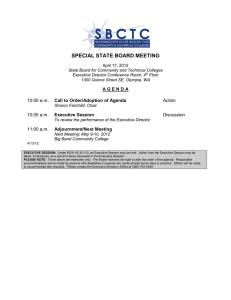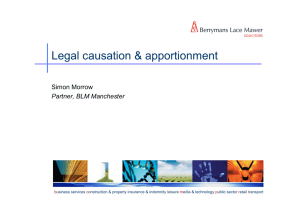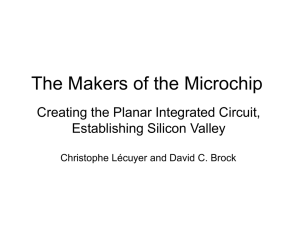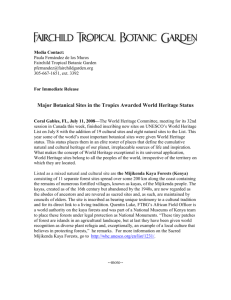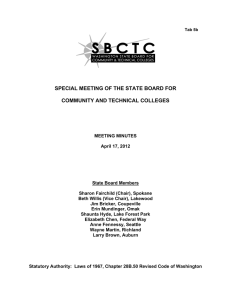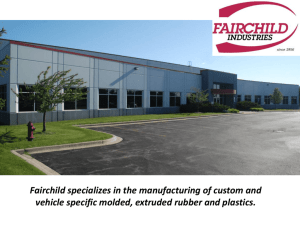ARTHUR ROCK Arthur Rock
advertisement
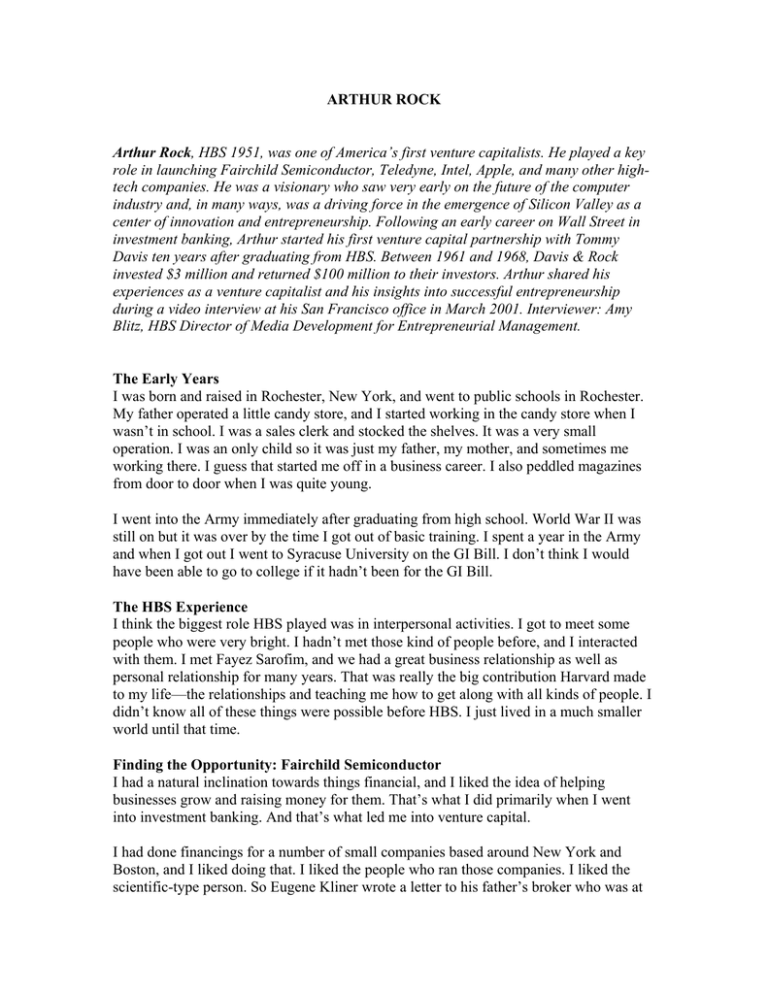
ARTHUR ROCK Arthur Rock, HBS 1951, was one of America’s first venture capitalists. He played a key role in launching Fairchild Semiconductor, Teledyne, Intel, Apple, and many other hightech companies. He was a visionary who saw very early on the future of the computer industry and, in many ways, was a driving force in the emergence of Silicon Valley as a center of innovation and entrepreneurship. Following an early career on Wall Street in investment banking, Arthur started his first venture capital partnership with Tommy Davis ten years after graduating from HBS. Between 1961 and 1968, Davis & Rock invested $3 million and returned $100 million to their investors. Arthur shared his experiences as a venture capitalist and his insights into successful entrepreneurship during a video interview at his San Francisco office in March 2001. Interviewer: Amy Blitz, HBS Director of Media Development for Entrepreneurial Management. The Early Years I was born and raised in Rochester, New York, and went to public schools in Rochester. My father operated a little candy store, and I started working in the candy store when I wasn’t in school. I was a sales clerk and stocked the shelves. It was a very small operation. I was an only child so it was just my father, my mother, and sometimes me working there. I guess that started me off in a business career. I also peddled magazines from door to door when I was quite young. I went into the Army immediately after graduating from high school. World War II was still on but it was over by the time I got out of basic training. I spent a year in the Army and when I got out I went to Syracuse University on the GI Bill. I don’t think I would have been able to go to college if it hadn’t been for the GI Bill. The HBS Experience I think the biggest role HBS played was in interpersonal activities. I got to meet some people who were very bright. I hadn’t met those kind of people before, and I interacted with them. I met Fayez Sarofim, and we had a great business relationship as well as personal relationship for many years. That was really the big contribution Harvard made to my life—the relationships and teaching me how to get along with all kinds of people. I didn’t know all of these things were possible before HBS. I just lived in a much smaller world until that time. Finding the Opportunity: Fairchild Semiconductor I had a natural inclination towards things financial, and I liked the idea of helping businesses grow and raising money for them. That’s what I did primarily when I went into investment banking. And that’s what led me into venture capital. I had done financings for a number of small companies based around New York and Boston, and I liked doing that. I liked the people who ran those companies. I liked the scientific-type person. So Eugene Kliner wrote a letter to his father’s broker who was at Hayden Stone. And that broker, knowing of my interest in these kinds of companies, showed me the letter. I thought, well, maybe there’s something to it. The letter said that there were seven scientists who were part of a group at Shockley Laboratories developing silicon semiconductors, and that they were extremely unhappy with Shockley. Shockley, of course, was one of the co-inventors of the transistor. And he had a complete lifestyle change after he invented the transistor. He divorced his wife and decided to move to Palo Alto. And then with his Nobel Prize he was able to recruit almost anybody he wanted to because there weren’t many entrepreneurial jobs in those days. So he was able to recruit these scientists, seven of whom got together and asked Eugene Kliner to write this letter. Actually, the letter was typed by Kliner’s wife. The letter said that they were unhappy with Shockley and they were going to quit, but did we know of anyone who might hire them together as a group? They weren’t looking especially to form a company. That was my idea. I came out to see them with one of the partners of Hayden Stone and we talked to them. They had all been chosen by Shockley, so I knew they were probably pretty good people, and then when we met them I was very impressed and thought we could help them. I suggested to them that they might want to set up a company, and we told them we would see if we could get financing for the company. We had a couple more meetings with them. Then they brought along an eighth fellow who was Bob Noyce, so that was the “traitorous eight.” We, Hayden Stone together with the eight of them, put together a list of companies that might finance this group. We had about thirty-five companies, all of whom had expressed an interest in going into new fields. We talked to each of these thirty-five companies. I personally visited most of them. And their reply was, well, this is a great idea, but if you set up a separate company, then what will our other employees think; it will just upset our organization, so we don’t want to do it. So we crossed out all thirty-five and were at our wit’s end when somebody introduced me to Sherman Fairchild. Sherman Fairchild was one of the largest shareholders of IBM stock. His father had gone into partnership with Tom Watson in setting up IBM, and since Tom Watson’s family consisted of three or four children and Sherman Fairchild was the only heir in his family, he owned a lot of stock. So he had a lot of cash and he was an inventor. He had invented the aerial camera, and as a result had formed Fairchild Camera and Instrument Company. And then he had to invent the airplane that could hold the camera, so that was the basis for Fairchild Aviation. He also liked young people and saw the merit in our idea, so he agreed that Fairchild Camera and Instrument Company would finance this group. They advanced what we then named Fairchild Semiconductor a million and a half dollars in return for an option to buy all of our stock for $3 million. We then split up Fairchild Semiconductor: 10 percent to each of the eight and 20 percent to Hayden Stone. I had previously done a transaction for a company called General Transistor, which made germanium transistors, and so I had some knowledge of the semiconductor market. The initial use for semiconductors was in hearing aids because previous ones used vacuum tubes and you can imagine how cumbersome that was. But as I did some research into it, Rock -2- it appeared to me that semiconductors could take the place of all vacuum tubes, and that’s how it turned out. They weren’t used in computers at first, but it was perfectly evident to anyone who studied the subject that it wouldn’t be long before they were. Transistors at that time were made of germanium, and Shockley was working in silicon, so of course Fairchild Semiconductor planned to work on making transistors from silicon. With research and talking to scientists, you could ascertain that silicon was a better way to go. So they began working on these devices to replace vacuum tubes, and they got a big boost from the space effort and missile industry. There was a big effort in ballistic missiles at that time, and these missiles had a problem with heat. Germanium transistors didn’t work well under high temperatures, or under ambient temperatures, and silicon did. Fairchild Semiconductor got a big grant from the government to pursue transistors for the space effort. I didn’t have much of a role after that. I kept in touch with the people of course. And I spent time with them, but Fairchild Camera and Instrument really ran that company, and they didn’t want any outsiders. Sherman Fairchild subsequently passed away, and Fairchild Camera and Instrument was really an eastern-type company; they wanted to run things their way. That’s why people then left Fairchild Semiconductor and formed Intel and other companies. But there would not have been any silicon in Silicon Valley if it hadn’t been for the formation of Fairchild Semiconductor because the “treacherous eight” would probably have just and gone off and gotten jobs individually. My guess is a lot of them would have ended up with Texas Instruments, which had a similar but less successful enterprise going in Texas. The problem at Fairchild Semiconductor had to do with incentives. The whole idea of giving people incentives was something foreign to most companies. That’s one of the reasons, of course, that I came out to California; I saw that people were a lot more adventuresome in California than they were in the East. In the East, it’s the old establishment and old money. People have been doing things one way for a long time and it’s very hard to change. It actually took many, many years for them to change, whereas people who came out West had some of the “Go West, young man,” Wild West aura about them, and they were willing to do things to test new ideas. I found that really the brighter, more imaginative, adventuresome people were out here rather than in the East. Another company I helped start was Scientific Data Systems (SDS). That was really the first company to ever offer stock options to all employees. Several companies before that time had, so I didn’t invent the idea of the stock option, but most companies just offered options to key executives. No one went further than that. “Employees with a quarter of 1 percent of the stock? What’s the point?” I think they felt. It’s hard for me to know what the employees thought, but my guess is that they really liked to feel they owned part of the company, no matter how little. And as you get higher up in the company, you want to own more. That’s really what started it out here. Rock -3- But this area wasn’t called Silicon Valley then. It was named that in the mid-1970s by some journalist and then it just caught on. Before that people just referred to it as the peninsula. What’s going on down on the peninsula? So when we came out with Fairchild Semiconductor, that was my first trip here and I liked what I saw. I liked the energy. I liked the people. I liked the opportunities. And then people started talking to me about various deals out here. So we did a few of them, and they worked out. In 1961 I met Tommy Davis, who was at that time a vice president of Kern County Land Company, and Kern County Land Company collected royalties on all their oil properties in the Bakersfield area. And they wanted to put some of these monies to work. They hired Tommy to try to invest their monies; he did one deal and then he came to them with several others. And they said, wait, wait, wait, we want to wait a few years to see how this one deal turns out. Tommy, of course, wasn’t happy with that. So someone introduced us and we decided to form a partnership in 1961 and I moved out to California. Teledyne I’d been introduced to Henry Singleton and George Kozmetsky before I moved to California. They were both vice presidents of Litton Industries and they ran a division focused on electronics. Henry was as intellectual as anyone I had come across. He was really brilliant. He had invented the gyroscope, which was used in airplanes and spaceships and missiles to keep them oriented, and that was a huge invention. During the war, he had invented a method for degaussing submarines, which allowed our submarines to go by German submarines without being detected. It was a huge invention and made the seas a lot safer during the war. So he was running this division of Litton with George Kozmetsky and we at Hayden Stone financed them in forming Teledyne. I became a director of Teledyne and soon after formed the partnership with Davis, and we invested in Teledyne. I then became very involved in the early stages of Teledyne. I was always more interested in building companies than in building a business for myself. I didn’t foresee how big the venture capital business would become, but I don’t think it would have ever interested me anyway to build a big venture capital investing firm. I liked to invest in just a few companies and be associated with them and help them grow. So I spent a lot of time in those days with Teledyne and also with SDS. At Teledyne, we started out by buying a defunct company that had lost all of its military contracts and was about to go broke. Teledyne bought it for very little money and then was able to get contracts and build that business up. Then during the next ten years we bought about 125 companies, most of which had something to do with scientific products. There was no general theme. This was a conglomerate of scientific companies, and most of these were allowed to operate with very little direction from corporate. Henry Singleton was this very brilliant, intellectual type who could foresee all of these problems that no one else saw, and he saw the opportunities. I was the sounding board for Henry. He’d call me up all the time. What did I think about this, what did I think about Rock -4- that? We went on a stock buy-back program. We reduced the number of shares by 90 percent during the period probably from 1980 to 1995. We just kept on buying back stock and that, of course, increased the value for the remaining shareholders. So we used to talk about that and whatever problems the company had. I spent a lot of time in Los Angeles and had a lot of dinners and lunches with Henry. And for the twenty-five years that he ran Teledyne, we compounded the growth at 25 percent a year for twenty-five years. But Henry, despite all his brilliance and braininess, had a tough time developing people. So after he left, things started to deteriorate quite a bit. Teledyne was eventually sold to Allegheny Corp. after we spun off the two insurance companies. And the stockholders made out extremely well. Intel Fairchild Semiconductor was run by this autocratic group out of Syosset, Long Island. In 1967, the last full year for Bob Noyce and Gordon Moore at Fairchild, they made 110 percent of Fairchild Camera and Instruments’ profits. They felt that they and the employees ought to be rewarded better, that they ought to have more autonomy, and they just started having problems with the people in Syosset. So they decided to leave, and of course I was located out here by then. This was 1968. They called me one day and told me what they were thinking and said they wanted to form a company: what did I think? I told them I thought they could do it and said they needed to raise $2.5 million. I thought that was possible and agreed on the terms. There was no negotiation; everything was done right very quickly. I made a few phone calls and raised the $2.5 million. At the time, memories were made of magnetic cores, and their idea was to make memories out of silicon devices. I had some experience with core memories because I was associated with a company called Electronic Memories and knew the people there pretty well. Today, if all memories were made with magnetic cores, we would probably need to employ more people than there are in the whole world just to string these cores together. They had to be threaded and someone had to do that. But in any event, the idea of having semiconductor memories seemed to me to be a good idea. I didn’t do much checking, but what checking I did do showed me that my instincts were right. Of course I was still associated with SDS and they thought as well that it would be a good idea to be able to reduce the size of computers appreciably. There was no competition at that time. This was their idea and they just carried it through. I was never 100 percent sure that a company would make it, except for Intel. Of that I was absolutely sure, because Noyce and Moore had done such a great job at Fairchild Semiconductor and the opportunity seemed to me to be wide open. I liked opportunities that seemed to have no limit. And this seemed to be that kind of opportunity. I thought the invention of the transistor was one of the seminal events of the last fifty years, and I just saw that so many things were being done that could be done better if they were smaller and done with semiconductor devices. Of course I never foresaw the microprocessor, but that was really key to all of the advances that were made in any devices that were electronic since that time. You couldn’t have had personal Rock -5- computers, ultrasound devices, MRI devices; none of these things would have been possible without the invention of the microprocessor. I get my kicks out of building companies and in the beginning I used to go to all the staff meetings once a week. I doubt whether Bob or Gordon would have made a big decision without talking to me first about it. So we batted things around and things worked out. But I think Gordon is going to go down in history more for the invention of Moore’s Law than for the formation of Intel. It was just an observation he made. He just put a ruler on a semi-log table and saw that every eighteen months the number of transistors in a chip doubled and then he extrapolated the law from there, the law that the number of transistors on CPUs doubles every eighteen months. It’s just an observation. People make a big thing out of it, but I don’t think Gordon would. Apple Mike Markula had been a vice president of marketing at Intel and he made enough money in his stock options that he felt he could retire at an early age, but he just couldn’t sit still. He had all kinds of things going and he was very curious about things. He called me one day and said, “I want you to come look at this personal computer thing I’ve got.” I guess he came and showed me the computer, and I didn’t think very much of it one way or another. And then he called me and said, come on down to the homebrew computer show in San Jose. So I went down. It was a big convention hall, similar to all of the other types of electronics shows with booths all over the place. And when I walked in, there was nobody in any of these booths. I couldn’t quite figure it out. Then I got to the Apple booth and I couldn’t get close to it. I couldn’t even get close enough to see the products. People were lined up, trying to get into this booth and look at the products. I just figured to myself, there’s got to be something here. Then I met Steve Jobs and Steve Wozniak. They kind of turned me off as people. Steve had a beard and goatee, didn’t wear shoes, wore terrible clothes, hair down to his collar, and probably hadn’t had a haircut in twenty years. But because Mike was so interested, and he had by that time bought a third of the company, I decided that I’d make an investment. And it turned out to be a pretty good investment. Steve’s rhetoric, and he had plenty of rhetoric, was that everybody would use a personal computer eventually. I didn’t think it would be quite as big a market as it turned out to be. But I could see people spending $2,000 and $3,000 to buy computer for their own use. The idea of a personal computer got pooh-poohed at first because the only application people could think of initially was putting menus on the computer and putting the computer in the kitchen so a housewife could pull up her menus from the computer. That seemed kind of hokey to me. But in any event, I thought maybe there would be a market, and it turned out to be that there was. My role at Apple wasn’t quite as great as it was at Intel or SDS or Teledyne. I didn’t have as big an investment, and I wasn’t the original investor. I was kind of the next stage, first venture capital round. But I spent a lot of time with Apple. While Steve Jobs and I don’t Rock -6- have a great relationship at this point, we certainly don’t dislike each other, and I do still have a great relationship with Mike Markula. I enjoyed that very much. The problem here was just keeping Steve Jobs focused. Eventually we had to bring in John Sculley. There are three stages in a company’s life. There’s the first stage where the entrepreneur does things himself. He goes into the lab. He develops things. He makes sales calls. He sets the tone for marketing. Then there’s the second stage where, if the company grows, the entrepreneur then does things through other people. He has a vice president of sales, a vice president of marketing, a vice president of engineering, but he keeps on top of everything. Then if the company grows to a third stage the entrepreneur no longer has any direct control over things. A lot of people can’t handle that stage, and that of course is what happened at Apple. Steve Jobs, what was he—twenty years old, twenty-one years old? He was just not capable of doing that. And he recognized that. So we tried to recruit a CEO to replace Steve. I don’t like recruiting, personally. I’d rather have a B-player whom I know than an A-player or a potential A-player from the outside. And then 50 percent of the people you recruit to be CEO never stay. Somehow, the headhunter we used found John Sculley. John used a computer a great deal and knew all about it, but he was in the soft drink business and he really wasn’t much interested in becoming CEO at Apple. Then Steve Jobs in this famous, famous line, looked John Sculley in the eye and said, “Do you want to be making soft drinks for the rest of your life? Is that the kind of contribution you want to make to society? I’m giving you this great opportunity to contribute something.” And Sculley bit. We had him and his wife and the directors of the company to our house for dinner, and we tried to convince him that he should take this job and he finally did. Diosonics I was involved with a company called Diosonics. It was a medical instrument company that was one of the first developers and manufacturers of ultrasound equipment. They also developed MRIs—magnetic resonance imaging machines—which are used all over the world in hospitals for diagnosis. And we ran into some problems there. One of the main problems was related to accounting. I think that accounting is a very serious issue in a lot of companies. The need to make profits every quarter and to meet analysts’ estimates can be a debilitating force. In this case, I just wasn’t on top of it. I should have been, but the management there booked some sales that weren’t sales and cooked the books a little bit and we paid the price for it. Another lesson from that same company was that as we developed the market for MRI machines, General Electric and Siemens decided that they wanted to get in the business. And the way they took away most of the market was by going to hospitals and financing the equipment, which we could not do. They went into hospitals and said, “Try this machine.” These were $1.5, $2 million machines, and they went into the hospitals and said, “Try the machine. Keep it for a year. Don’t pay us. If you like it, pay us in a year, pay us in two years. No hurry.” And they just beat us. So that’s something else to watch for. But the main problem with Diosonics was in the accounting. Rock -7- Difficult Decisions Difficult decisions require intellectual honesty, being able to see things as they are, not as you want them to be, and then facing up to problems and doing something about them. Probably one of the great management decisions I know of was when Intel decided to leave the memory business. I think most companies would have just tried to tough it out. But the Japanese were formidable competition, and they were selling their products below cost. We couldn’t get the government to help us. We had just developed the microprocessor and had no idea how big a product that would be. The Intel management decided that we’d get out of the memory business, which was two-thirds of our business then. We had to lay off a third of our people and we had a big loss that year, in the early ’80s. But somehow we weathered the storm and got through it and built a bigger and better company. The toughest part was laying off a long-time workforce. That’s really tough. We had to close plants. I think that’s as tough a decision as we’ve ever had to make. Deciding where to invest is obviously key as well. Anyone who comes into the office and says, well, I have this business plan and you’re going to make a lot of money if you invest with me, doesn’t stand another two or three minutes with me because that’s not what it’s all about. It’s about building companies. If someone wants to get rich, let them go someplace else. They probably won’t make it. Beyond that, I think intellectual honesty is really the key. And drive, fire in the belly. Those are qualities I look for when considering where to invest. Things have changed quite a bit since I started doing this, though. I don’t think I could do the same deals today because there’s so much competition from the venture capital side and from people wanting to do deals all the time. You don’t have time to really look at the deals, figure them out, and get to know the people. And the competition is so much greater if you start a business; you don’t know what other people are doing. There are so many other start-ups that by the time you get your products out there might be two or three companies doing exactly the same thing. We didn’t have that. When we started SDS, there was no one else making scientific computers, and no one did make scientific computers until Digital Equipment started doing it much later. The same was true with Fairchild Semiconductor and with Intel. No one else was doing these kinds of things, so we had room to make mistakes. If projects took a little longer, they took a little longer. Today you don’t have that room. The point I’m getting at is that today, to be a venture capitalist, you need to be a scientist or an engineer to understand the products well enough to know whether it’s possible that somebody else might be doing the same thing, and also whether it’s technically any good. Because today if you make a mistake and come out with the wrong products, you’re dead. Forty years ago if you came out with the wrong product, you could make a change. So I don’t think it would have been possible for me to do today what I did then. Rock -8- One thing that probably hasn’t changed is the need to be a good listener. I’m a really good listener. The first time you meet with somebody, everybody’s on their good behavior and everybody comes across as being good entrepreneurs. It’s not until you spend a lot of time with them that you figure out whether your first impressions were right or not. Some people tend to contradict themselves. They’ll tell you one thing in one meeting and another thing in another meeting. And if you show an interest in one thing, they’ll dwell on that, and then later on they’ll contradict themselves. So I’ve spent a lot of time listening to people and figuring out whether I thought they were good people and whether I could get along with them. Some people are very, very good at finding good people to work with, and other people aren’t that good. Singleton, for instance, was not very good at finding good people. Noyce and Moore were terrific at it. Ideas are a dime a dozen. It’s the execution that’s really the important thing and you need really good people for that. Good people can change directions, but there are very, very few truly great people who can execute properly. And that’s what the people at SDS, and Teledyne, and Intel did; they executed well. Summary Thoughts Success breeds success. People here in Silicon Valley saw what could be done and then they thought they could do it better, and so it went. But the real motivator for the success of Silicon Valley was the development of the microprocessor. That just opened up all kinds of opportunities in software, hardware, medical instruments; you name it. None of these things would be possible without the microprocessor. It also opened up opportunities for venture capitalists to be able to raise money to invest in more of these companies. Looking back, I think my biggest accomplishment was starting the venture capital business if, in fact, I did that. If I have to go down in history for doing one thing, I guess that’s it. But success for me is in helping to build great companies. That’s how I get my kicks. Having money is nice. Being able to travel and do the things I want to do is all very nice. But I would give up some of that for the feeling of success, of having created jobs. I helped create jobs. I helped create companies. I helped create wealth for a lot of people. That gives me a great deal of satisfaction. Rock -9-
